

A triangle-based pyramid has four triangular sides.The base of a triangle pyramid can be any type of triangle, but is usually an equilateral triangle. This means that all sides and faces are the same. When rotated or placed in any position, it will look the same.
A triangle-based pyramid is unique in comparison to other pyramids, as it only consists of one kind of 2D shape, a triangle.

Triangle-based pyramids are formed exclusively of triangles. You can easily recognise a triangle-based pyramid by looking at the triangular sides that slant upwards from the triangular base.
A triangle-based pyramid consists of 4 triangles, because of this, a triangle-based pyramid is also known as a tetrahedron. If all faces are equilateral triangles, the pyramid is termed a regular tetrahedron. If the triangles have edges of different lengths, the pyramid is an irregular tetrahedron.
Triangle-based pyramids have 6 edges. They have 3 along the base, and 3 extending up from the base. If the 6 edges of the triangle based pyramid are equal in length, the triangles are equilateral, and the triangle based pyramid is a regular tetrahedron.
All triangle-based pyramids have 4 vertices, regardless of whether they are regular tetrahedrons, or irregular tetrahedrons.
The top of the pyramid is called the apex. This is where the edges meet in the middle.
The net of a triangle-based pyramid is made up of 4 triangles when laid flat. The base of the pyramid is a triangle, and the lateral faces are also triangles.

An example of a net of a triangle based pyramid
To work out the surface area of a triangle-based pyramid, you need to add together the area of the base plus the area of all of the sides.
For a regular tetrahedron, you need to find the length of the base, and the height of 1 of the triangles. Then, you multiply these measurements together and divide the answer by 2.
The number you have as the answer is the area of 1 of the triangles.Then, multiply this number by 4 to account for all faces on the pyramid.
For an irregular tetrahedron, you need to find the area of each triangle individually, then you need to add all areas together.
If you want to work out the volume of any triangle-based pyramid, you need to multiply the area of the triangle base by the height of the pyramid.
You measure the height from the midpoint of the base to the apex. Then you divide this number by 3 to get your answer.

Take a look at this list of useful facts below to help you remember more about triangle-based pyramids:
Take a look at some fantastic resources available you might like to use to aid your teaching on 3D shapes.
 Home
Home  Membership
Membership  Customer Support
Customer Support  Create
Create  Blog
Blog 




















